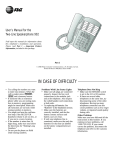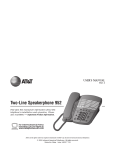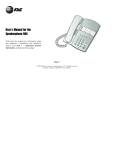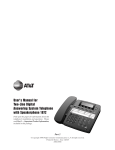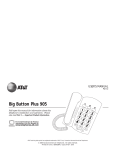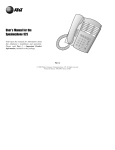Download AT&T 272 User`s manual
Transcript
1 USER’S MANUAL Part 2 Two-Line Memory Telephone 272 Please also read Part 1 — Important Product Information AT&T and the globe symbol are registered trademarks of AT&T Corp. licensed to Advanced American Telephones. © 2000 Advanced American Telephones. All rights reserved. Printed in Mexico. 850003518 Issue 1AT&T 5/00 CONTENTS INSTALLATION ................................. 3 TELEPHONE MEMORY ................... 11 Table/Desk Installation ......................... 4 Wall Installation .................................... 5 Directory Card .................................... 11 Storing Memory Numbers .................. 11 Dialing Memory Numbers ................... 11 Dialing Long Numbers ........................ 12 Erasing Memory Numbers .................. 12 TELEPHONE OPERATION ................. 7 Making a Call ......................................... 8 Answering a Call ................................... 8 Line Status Lights .................................. 8 Redial .................................................... 8 Hold ...................................................... 8 Switching Between Lines During a Call ..................................... 9 Conference Calls ................................... 9 Conference Call Options ....................... 9 Flash .................................................... 10 Temporary Tone .................................. 10 Ringer Volume ..................................... 10 Receiver (Handset) Volume ................. 10 IN CASE OF DIFFICULTY ................ 13 1 2 INSTALLATION NOTE: To use this product as a two-line phone, you must have either a two-line modular jack, or two separate one-line modular jacks. To use both lines of a two-line telephone, your local telephone company must provide two telephone numbers. 1 Install or replace the batteries (not included). • These batteries are needed to illuminate the line status lights. When battery power is low, the line status lights dim or don’t go on. CAUTION: Always unplug the line cord before installing batteries. • Turn the phone upside down, open the battery compartment door, and insert AAA batteries. Close the battery compartment door. NOTE: If you are connecting only Line 1 or only Line 2, use two batteries, as indicated on the bottom of the phone. If you are connecting both lines, use four batteries. 2 Set the dial mode. This telephone will work with touch tone or dial pulse (rotary) service. Even when set to dial pulse service the phone can be switched temporarily to tone mode for access to services that require tone signaling, including some tone-activated computer systems. To switch from pulse to tone dialing during a call, see “Temporary Tone” in the TELEPHONE OPERATION section of this manual. This phone comes set for touch tone dialing. Use the switch on the handset to select TT (tone) or DP (dial pulse), depending on your service. Touch tone dialing will not work if you have dial pulse service. 3 INSTALLATION Table/Desk Installation Follow Steps 1 and 2 above. 3 Connect the long line cord(s) to the telephone. • If you have a two-line wall jack, use only the line cord with the clear modular plugs on each end. Plug one end into the jack labeled L1 OR L1/L2 on the bottom of the telephone. Thread the line cord through the groove on the bottom of the telephone so the set will lie flat on your table. • If you have two separate wall jacks, use both line cords. Insert one end of the cord with blue plugs into the jack labeled L1 OR L1/L2 on the bottom of the telephone. Insert one end of the cord with clear plugs into the jack labeled L2 on the bottom of the telephone. Thread the line cords through the groove on the bottom of the telephone so the set will lie flat on your table. L1 or L1/L2 jack Thread line cord through groove so set lies flat on table L2 jack 4 4 Connect the line cord(s) to your modular wall jack(s). • If you have a two-line jack, plug the free end of the line cord into the modular jack. Make sure the cord snaps firmly into place. • If you have two separate jacks, plug the free end of the cord with blue plugs into the modular jack for Line 1. Plug the free end of the cord with clear plugs into the modular jack for Line 2. INSTALLATION 5 6 7 Connect the handset to the telephone. Plug the coiled cord into the handset jack on the side of the phone. Plug the other end of the coiled cord into the handset. Check for dial tone. Lift the handset, press L on the base, and listen for a dial tone. Then press l on the base. If you do not hear a dial tone, turn to IN CASE OF DIFFICULTY. Confirm Lines 1 and 2. To determine which line is which, press L on the base and call one of your telephone numbers. If you hear a busy signal, Line 1 is the number you called. If Line 2 rings, it is the number you called. Wall Installation L1 or L1/L2 jack L2 jack Thread line cord through groove so set lies flat Follow Steps 1 and 2 above. 3 Connect line cord(s) to telephone. • If you have a two-line wall jack, use only the short line cord. Plug one end into the jack labeled L1 OR L1/L2 on the bottom of the telephone. Thread the line cord through the groove on the bottom of the telephone. • If you have two separate wall jacks, use the short line cord and one of the long cords. Plug one end of the short line cord into the jack labeled L1 OR L1/L2 on the bottom of the telephone. Plug one end of the long line cord in the jack labeled L2 on the bottom of the telephone. Thread the line cords through the groove on the bottom of the telephone. 5 INSTALLATION 4 5 6 Connect the line cord(s) to your modular wall jack(s) and mount the telephone on the wall jack. • If you have a two-line jack, plug the free end of the short line cord into a modular wall jack. Make sure the cord snaps firmly into place. Place the phone on the wall jack mounting studs and pull down until it is held securely. • If you have two separate jacks, plug the free end of the long line cord into the jack where you are not mounting the phone (baseboard jack). Plug the free end of the short cord into the jack where you are mounting the phone. Make sure the cords snap firmly into place. Place the phone on the wall jack mounting studs and pull down until it is held securely. Follow Steps 5, 6, and 7 in “Table/Desk Installation.” TELEPHONE OPERATION RINGER Line 1 Volume Control Directory Card RINGER Line 2 Volume Control Connect a conference call Line 1 Line 2 Put a caller on hold Receiver Volume Control Memory locations (may be used to store emergency numbers) Temporary Tone Flash Redial last number called Access numbers in telephone memory Touch Tone or Dial Pulse switch Program memory numbers 7 TELEPHONE OPERATION Making a Call Press L or l and lift the handset. You can dial your call manually or use the Memory Dialing feature (see “Dialing Memory Numbers” in the TELEPHONE MEMORY section of this manual). Answering a Call Each line has a different ringer tone to signal an incoming call. One of the line status lights will flash to identify the ringing line. To answer a call, press the appropriate line button and lift the handset. To hang up, replace the handset. Line Status Lights Whenever a line is in use (at this telephone or any extension), the line status light for that line is on. When a call is put on hold at this phone, the light for the line on hold blinks. Redial The telephone always stores in redial memory the last number you manually dialed at this phone (up to 32 digits). The number remains in memory until you dial another number. To dial the last number you called, press L or l, lift the handset, and press R. Hold The Hold feature allows you to keep a call on the line while you step away from the phone, switch lines, or while someone takes the call on an extension phone. When a call is put on hold at this phone, the line status light for the line in use flashes; nothing either party says can be heard. You cannot access any special features. To put a call on hold, press and release H and place the handset back in the cradle. To release Hold, lift the handset and press the appropriate line button — OR — Lift the handset of an extension phone of the line on hold — OR — If the handset is not in the cradle, press and release the appropriate line button. 8 TELEPHONE OPERATION Switching Between Lines During a Call During a call on one line, you can make or answer a call on the other line by pressing H. You can use the H and line buttons (L and l) to switch back and forth between calls as often as necessary. For example, if you’re using Line 1 and Line 2 rings: 1 Press H to hold Line 1. 2 Press l to answer the other call. 3 Press L to hang up Line 2 and return to your first call — OR — Press H to hold Line 2, and press L to return to your first call. Conference Calls You can use both lines at the same time to set up a three-way conference call. 1 Make or answer a call and press H. 2 Establish a call on the other line. 3 Press F. 4 Hang up to end a conference call. If one caller hangs up during a conference call, you might hear a dial tone. Press the line button of the remaining call to disconnect the other line and eliminate the dial tone. NOTE: Under certain circumstances, the other parties on a conference call may not hear one another clearly. Conference Call Options Placing a Conference Call on Hold 1 2 Press H to hold both lines. Press F to release Hold and continue your conference call. Talking Privately with One Caller 1 2 3 Press H. Press the line button of the person with whom you want to speak privately. Press F to continue your conference call. 9 TELEPHONE OPERATION To disconnect one party from a conference call and keep the other on the line, press the line button of the call you want to continue. NOTE: If you leave the F button down after a conference call, then dial another number, your call might be completed, but you might hear a busy signal from the other line. Press H, then press each line button until you identify the line being used for your completed call. Flash The F button is useful if you have subscribed to custom calling services from your local telephone company. Press F instead of pressing the switchhook to activate services such as Call Waiting or 3-Way Calling. You may have to press other buttons before or after F as explained in the custom calling instructions provided by your local telephone company. The F button is used only as a substitute for pressing the switchhook. Temporary Tone If you have dial pulse (rotary) service, you can change from pulse to tone dialing during a call by pressing t. This is useful if you need to send tone signals to access telephone banking or long-distance services. 1 Dial the telephone number. 2 Press t. All buttons pressed after this send tone signals. 3 After you hang up, the phone returns to pulse dialing. Ringer Volume This phone has two separate RINGER switches, one for each telephone line. You can set each switch to OFF, LO or HI. You can dial and answer calls normally with one or both switches set to OFF. Other telephones in your home will still ring; they are not affected by the switches on this phone. If this is the only telephone in your home, you will not hear any incoming calls while both ringers are off. However, the light next to one of the line buttons will always flash when you have a call. Receiver (Handset) Volume Use the receiver VOLUME switch on the side of the phone to adjust the handset volume to a comfortable listening level. 10 TELEPHONE MEMORY This telephone can store up to 12 telephone numbers (up to 21 digits each). Directory Card Remove the plastic cover from the directory card on the base. Write your telephone numbers in the spaces provided, and write the telephone numbers (or names) that you want to store in each memory location. NOTE: You may choose to store emergency numbers in memory locations. This feature is provided only as a convenience. The manufacturer does not assume responsibility for customer reliance upon this memory feature. Storing Memory Numbers 1 2 3 4 5 Press L or l. Press and release p. Enter the telephone number you want to store. You will hear a beep each time you press a button. Press and release memory button , or — OR — Press m and the memory location (1–9) where you want to store the number Hang up after the number is stored correctly. Repeat Steps 1 to 5 to store another number in memory. Dialing Memory Numbers 1 2 3 Press L or l. Lift the handset and listen for a dial tone. Press and release memory button , or — OR — Press m and a memory location (1–9). 11 TELEPHONE MEMORY Dialing Long Numbers There are two ways to dial telephone numbers that are too long to fit into a memory location. Using Two Memory Locations You can store a number more than 21 digits long by dividing it and storing it in two memory locations. See “Storing Numbers in Memory” to store the number in two memory locations. To dial, lift the handset, select a line, listen for a dial tone, then 1 Press and release memory button , or — OR — Press m and the memory location (1–9) for the first part of the number, and wait for the dialing to stop. 2 Press and release memory button , or — OR — Press m and the memory location (1–9) for the second part of the number. Combining Manual and Memory Dialing Instead of using two memory locations, you might choose to store only part of a long number. You can use memory dialing to dial the stored portion, and dial the other digits manually. If the stored portion is dialed first, wait for dialing to stop before you continue with manual dialing. Erasing Memory Numbers To remove any number from memory, enter another number in the same location. NOTE: Numbers programmed into the memory locations may not be retained if the telephone has been unplugged from the line jack for 30 minutes or more. 12 IN CASE OF DIFFICULTY If this telephone does not work properly, try the following suggestions before seeking repair assistance. If the telephone still does not work, call 1 800 222–3111. No Dial Tone • • • • Make sure all plugs are connected properly. Check the line cord connections at the modular jack and at the telephone. Also check the coiled handset cord connection at both ends. Make sure you’ve selected Line 1 or Line 2. Make sure that Hold is not activated. Unplug the telephone and connect it to another modular jack. If it still does not work, and other telephones in your home are working, the problem is with this telephone. Call Cannot Be Dialed or Is Dialed Slowly • • This product comes set for touch tone (TT) dialing. Make sure you choose the correct dialing mode (TT/DP); touch tone dialing will not work if you have dial pulse service. If you just used Temporary Tone, leave the handset on the base for a few seconds before making another call. Difficulty Storing Numbers in Memory • • • • • • Review “Storing Memory Numbers” in the TELEPHONE MEMORY section of this manual to make sure you are pressing the correct sequence of buttons. If you are interrupted by a recorded announcement telling you to hang up (or a loud buzzing noise), hang up and try to enter the number more quickly. Try calling the number you want to enter into memory. When the call is ended: 1 Press p. 2 Press a memory location button , or — OR — Press m and the memory location (1–9) where you want to store the number. If someone lifts an extension phone while you’re storing numbers in memory, the process might be interrupted. Make sure all extensions are on hook while storing numbers in memory. If the number is more than 21 digits long, make sure you follow the directions for “Dialing Long Numbers” in the TELEPHONE MEMORY section of this manual. Do not put the phone on hold while storing numbers in memory. 13 IN CASE OF DIFFICULTY Problems with Line Status Lights • • Make sure all plugs are connected properly. Inspect the line cord connections at the modular jack and at the telephone. Also inspect the coiled handset cord connections at both ends. Try replacing old batteries. See the INSTALLATION section of this manual. Telephone Does Not Ring • • 14 Make sure the RINGER switches are set to LO or HI. If there are several other telephones on the same line, try disconnecting some of the other telephones. Having too many telephones connected can also create problems such as low ringer volume, or impaired sound quality during calls.
















